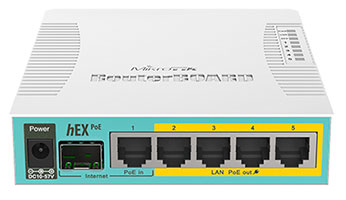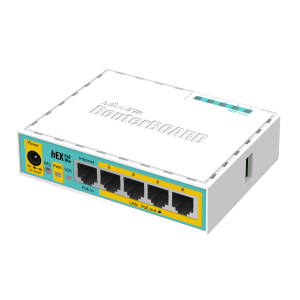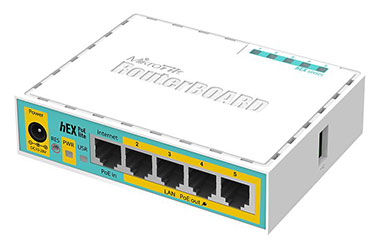Как подключить микротик через poe
Arxont
воскресенье, 3 ноября 2013 г.
FAQ по PoE (Power over Ethernet) в роутерах Mikrotik
Power over Ethernet (PoE) — технология, позволяющая передавать удалённому устройству вместе с данными электрическую энергию через стандартную витую пару в сети Ethernet. Данная технология предназначается для IP-телефонии, точек доступа беспроводных сетей, IP-камер, сетевых концентраторов и других устройств, к которым нежелательно или невозможно проводить отдельный электрический кабель.
5. Просмотреть текущее состояние PoE можно командой
interface ethernet poe monitor [find]
Правда мне данный параметр непонятен. В тестах, на 90 метровом куске кабеля, 750UP смог поднять 951G-2HnD. Может пригодится если больше длина или менее качественный кабель используется.
C использованием высокочастотных трансформаторов на обоих концах линии с центральным отводом от обмоток постоянное напряжение питания подается на центральные отводы вторичных обмоток этих трансформаторов, и так же с центральных отводов снимается на приемной стороне. Использование центральных отводов сигнальных трансформаторов позволяет без взаимного влияния передавать питание по сигнальным парам, то есть передавать по одним и тем же проводникам и высокочастотные данные, и постоянное напряжение питания.
Каталог устройств MikroTik
Настройка MikroTik hEX PoE (RB960PGS)
Описание
MikroTik hEX PoE (модель RB960PGS) — это роутер без Wi-Fi на 5 гигабитных сетевых портов, 1 SFP порт для подключения оптики и 1 USB порт для подключения 3G/4G модемов или внешних накопителей.
Сетевые порты 2-5 поддерживают подачу PoE питания на другие устройства, работающие по стандарту PoE 802.3af/at. Максимальный ток на один порт составляет 1А. Общий ток на всех портах не должен превышать 2А.
Напряжение на выходе ethernet портов 2-5 зависит от напряжения блока питания, которое подается на вход роутера. В комплект поставки входит блок питания с напряжением 24В, следовательно, на выходе будет напряжение 24В. Если на выходе ethernet портов нужно обеспечить напряжение 48В, то потребуется докупить блок питания на 48В.
Маршрутизатор MikroTik hEX PoE можно запитать по технологии PoE через первый LAN порт с напряжением 12-57 В. Для подачи питания через первый порт понадобится приобрести гигабитный PoE инжектор или POE блок питания.
Операционная система RouterOS Level4, установленная в маршрутизаторе, имеет очень большой функционал. Она позволяет настроить ограничения скорости, запретить торренты и социальные сети, создать VPN сервер, поднять защищенный IPSec туннель, PPTP, PPPoE, L2TP, настроить хот-спот для кафе или гостиницы с показом рекламы, RADIUS сервер, Proxy сервер, FTP сервер и многое другое.
MikroTik hEX PoE (модель RB960PGS) подойдет тем, кому нужно запитать другие устройства по PoE. Его оптический SFP порт обеспечит высокую скорость передачи данных и защиту от грозы при прокладке оптоволоконного кабеля по улице.
Настройка роутера MikroTik hEX PoE (RB960PGS)
Для настройки роутера MikroTik hEX PoE (RB960PGS) воспользуйтесь инструкциями:
PoE-Out
Summary
Sub-menu: /interface ethernet poe
This page describes how PoE-Out (Power over Ethernet) feature can be used on MikroTik devices with at least one PoE-Out interface. MikroTik uses RJ45 mode B pinout for power distribution, where the PoE is passed trough pins 4,5 (+) and 7,8 (-). If a device supports powering other devices using PoE-out, then it is recommended to use at least 18V as the input voltage, except for devices that support multiple output voltages (e.g. CRS112-8P-4S-IN, CRS328-24P-4S+RM, CRS354-48P-4S+2Q+RM).
MikroTik supported PoE-Out standards
MikroTik devices can support some or all of the following PoE standards:
Each PoE-Out implementation supports overload and short-circuits detection.
PoE-Out Configuration
PoE Configuration is supported on all MikroTik devices with PoE-Out interfaces, the configurations can be edited from the RouterOS and SwOS interfaces.
RouterOS
Usage
RouterOS provides an option to configure PoE-Out over Winbox, Webfig, and CLI, basic commands using the CLI are
| Property | Description |
|---|---|
| print () | Prints PoE-Out related settings. |
| export () | export is displayed under /interface ethernet menu. |
| monitor (string| interface) | Shows poe-out-status of a specified port, or all ports with /interface ethernet poe monitor [find] command. |
| power-cycle (time:0..1m |; Default: 5s) | Disables PoE-Out power for a specified period of time. |
Global Settings
Some MikroTik PoE-Out devices support the global PoE setting which can be configured under /interface ethernet poe settings menu. Global setting ether1-poe-in-long-cable feature disables strict input/output current monitoring (short detection) to allow the use of PoE-Out with long ethernet cables and/or avoiding improper short-circuit detection.
| Property | Description |
|---|---|
| ether1-poe-in-long-cable (yes | no) | Setting it to «yes» will disable short detection on all poe-out ports. This is potentially dangerous settings and should be used with caution |
Note: Global setting of ether1-poe-in-long-cable can also affect PoE-Out behavior on PSE which is powered using a DC connector
Port Settings
PoE-Out can be configured under the menu. Each port can be controlled independently.
Highest priority is 0, the lowest priority is 99. If there are 2 or more ports with the same priority then port with the smallest port number will have a higher priority. For example, if ether2 and ether3 have the same priority and over-current is detected then PoE-Out on ether3 will be turned off.
Note: If poe-voltage=auto and poe-out is set to «forced-on», LOW voltage will be used by default. If the PD supports only high voltage, make sure you also set poe-voltage=high when forcing the PoE output.
Power-cycle settings
RouterOS provides a possibility to monitor PD using a ping, and power-cycle a PoE-Out port when the host does not respond. power-cycle-ping feature can be enabled under /interface ethernet poe menu.
| Property | Description |
|---|---|
| power-cycle-ping-enabled (yes | no; Default: no) | Enables ping watchdog, power-cycles port if a host does not respond to ICMP or MAC-Telnet packets. |
| power-cycle-ping-address (IPv4 | IPv6 | MAC; Default: ) | An address which will be monitored. Since RouterOS 6.46beta16, an active route towards PD is required in case an IP address is configured, so make sure PSE can reach the PD. In case the MAC address is specified, PSE will send MAC-Telnet ping requests only from a specified ethernet interface. When configuring a bridge vlan-filtering or some way of VLAN switching, it is recommended to use the IP address for monitoring your PD. |
| power-cycle-ping-timeout (time:0..1h |; Default: 5s) | If the host does not respond for more than period of time, then PoE-Out port is switched off for 5s. |
| power-cycle-interval (time| any; Default: ) | Disables PoE-Out power for 5s between the specified intervals. Not related with the power-cycle-ping feature. |
If power-cycle is enabled, /interface ethernet poe monitor will show the actual status of the host and time when power cycle will be performed [1]
SwOS interface provides basic PoE-Out configuration options:
PoE-Out Monitoring
RouterOS
MikroTik devices with PoE-Out controller (not injector) provides port monitoring option. /interface ethernet poe monitor [find]
PD uses a second power source which has a higher voltage than PSE, so all current is taken from the second DC source, not PSE PoE-Out port;
If power-cycle-ping feature is used, /interface ethernet poe monitor [find] will show additional fields:
power-cycle-host-alive: (Shows if monitored host is reachable)
power-cycle-after: (Shows time, after which the port will be power-cycled)
It is possible to monitor PoE-Out values using SNMP protocol, this requires enabled SNMP on PSE. SNMP Wiki
SNMP values can be requested also from the RouterOS, for example, snmp-walk will print current mA from all available PoE-Out ports:
/tool snmp-walk address=10.155.149.252 oid=1.3.6.1.4.1.14988.1.1.15.1.1.5
To get very specific OID value, use snmp-get tool (displays current mA on ether3 interface):
tool snmp-get address=10.155.149.252 oid=1.3.6.1.4.1.14988.1.1.15.1.1.5.3
A PoE-Out controller will enable certain monitoring features also from SwOS, such as PoE-Out Status, PoE-Out Current, PoE-Out Voltage, and PoE-Out Power usage.
All PoE-Out configuration and monitoring is located on one page, under PoE tab https:// /index.html#poe :
PoE-Out notifications
PoE-Out LEDs
Models with dependant voltage output
PoE-Out LED behavior can differ between models, but most of them will indicate PoE-Out state on one additional LED. Devices with one voltage output will light:
Models with selectable voltage output
Models with multiple voltage options can indicate additional information:
Model-specific LED behavior
PoE-Out Logs
By default PoE-Out, event logging is enabled and uses «warning» and «info» topics to notify the user about PoE-Out state changes. Log entries will be added to each PoE-Out state change. Important logs will be added with a «warning» topic, informative logs will be added with the «info» topic.
To avoid unnecessary logging in cases when PD is not powered because of current-too-low, RouterOS will filter such events, and add one log per every 512 current-too-low events.
Logs can be disabled if necessary:
/system logging set [find topics
«info»] topics=info,!poe-out
/system logging set [find topics
PoE-Out Warnings in GUI/CLI
To notify a user about important PoE-Out related problems, messages will be shown in Winbox / WebFig and CLI interface fields:
1 RS ;;; poe-out status: overload
ether1 ether 1500 1588 9204 64:D1:54:61:D5:E0
WebFig and Winbox will notify user under interfaces:
How it works
PoE-Out Modes
auto-on mode
If auto-on is selected on PoE-Out interface, then port operates in this strict order:
forced-on mode
If forced-on is selected then port operates in this strict order:
off mode
If off mode is used, PoE-Out on the port will be turned off, no detection will take place, and the interface will behave like a simple Ethernet port.
PoE-Out limitations
It is important to check PoE-Out specification to find out hardware limitations because it can differ between models
PoE-Out port limitation
PoE-Out ports are limited with max amp values which are supported in particular voltage, usually max current will differ for low voltage devices (up to 30 V), and for high voltage devices (31 to 57 V).
PoE-Out total limitation
PSE has also a total PoE-Out current limitation which can’t be exceeded, even if the individual port limit allows it.
PoE Out polarity
All MikroTik PSE uses the same PoE-Out pin polarity Mode B 4,5 (+) and 7,8 (-), however other vendors can use opposite or Mode A pinout on PD, this would require using a special crossover cable.
Note: Passive PD with high input inrush current can result in overcurrent protection on PSE, make sure that PD specification supports powering from PSE (not only from the passive power injector)
Safety
PSE has the following safety features:
PoE-Out compatibility detection
The auto-on mode is considered safe, it will check if the resistance on the port is within allowed range and only then enable PoE out on the interface. The range is 3kΩ to 26.5kΩ
Overload protection
When a PoE-Out port is powered-on, it is constantly checked for overload. If the overload is detected, PoE-Out is turned off on the port to avoid damage to the PD or PSE.
Short circuit detection
When power is enabled on PoE-Out port, PSE continuously checks for a short circuit. If it is detected to ensure that there is no additional damage to PD and PSE, the power is turned off on all ports. PSE will continue to check PoE-Out port until the environment returns to normal.
Warning: Make sure that non-standard incompatible PD which does not have the resistance range 3kΩ to 26.5kΩ are not attached, so the PSE would not try to apply power on them
Model-specific features
Note: CRS328-24P-4S+, netPower 16P Poe-Out priorities work independently on each 8 port section!
PoE Out examples
RouterOS allows us to define priorities on PoE-Out ports, so if your installation is going overpower budget, the PSE will disable less important PD with the lowest priority.
Setting up priority
Example of how to set priorities from CLI:
/interface ethernet poe set ether2 poe-priority=10
/interface ethernet poe set ether3 poe-priority=13
/interface ethernet poe set ether4 poe-priority=11
/interface ethernet poe set ether5 poe-priority=14
Same priority
if all, or some ports will have the same poe-priority, then port with the lowest port number will have higher priority
/interface ethernet poe set ether2 poe-priority=10
/interface ethernet poe set ether3 poe-priority=10
/interface ethernet poe set ether4 poe-priority=10
/interface ethernet poe set ether5 poe-priority=10
In this example, if the total PoE-Out limit is reached ether5 will be turned off first, then ether4 then ether3 as all of these ports have same poe priority.
Monitoring PoE-Out
PoE-Out ports can be monitored using a command /interface ethernet poe monitor
[admin@MikroTik] > interface ethernet poe monitor [find]
name: ether2 ether3 ether4 ether5
poe-out-voltage: 23.2V 23.2V 23.2V
poe-out-current: 224mA 116mA 64mA
poe-out-power: 5.1W 2.6W 1.4W
Power-cycle ping
Monitor connected PD with power-cycle-ping feature:
/interface ethernet poe set ether1 power-cycle-ping-enabled=yes power-cycle-ping-address=192.168.88.10 power-cycle-ping-timeout=30s
In this example, PD attached to ether1 will be continuously monitored using a power-cycle-ping feature, which will send ICMP ping requests and wait for a reply. If PD with IP address 192.168.88.10 will not respond for more than 30s, the PoE-Out port will be switched off for 5s.
Troubleshooting
In cases where a PD does not power-up or reboots unexpectedly when powered from your PSE, it’s suggested to the first check:
Legacy
PoE-Out Controller upgrade
PoE-Out devices which are running RouterOS 5.x can also hold old PoE-Out controller firmware, upgrade to RouterOS 6.x will automatically update the PoE-Out firmware. Changes between 1.x and 2.x PoE-Out controller firmware will result in higher Max-port limits (0.5A to 1A) in case if it’s supported by the hardware, also will provide some additional data which can be monitored, and allow to use PoE-Out priorities.
All MikroTik devices which come with RouterOS 6.x already support the latest PoE-Out firmware.
Как подключить микротик через poe
Бесплатный чек-лист
по настройке RouterOS
на 28 пунктов
PoE порты на Mikrotik
Ну и не могу понять на самом деле как или в чем его использовать? столько много всяких стандартов PoE, что уже не пойму что куда и зачем.
У нас есть ТД, который работает по PoE, но уже понял, что это туда не подключишь, точнее подключишь, но как на обычный порт с инжектором отдельно. Тогда все же зачем он нужен? можете рассказать на простом языке?
Много читал, но чем больше читаю, тем больше запутываюсь с этими пассивными PoE OUT/IN.
Я бы так и делал, а то у него очень убогое питание. если случайно стонешь сзади разьема или провода, то отключается. хотя совсем новое оборудование. очень плохое качество.
А так спасибо за информацию. буду знать, что у микротика своя тема.
Существует три стандарта PoE: 802.3af, 802.3at, Passive. Первый и второй это самое настоящее PoE, где для питания используется линии данных, т.е. 1,2,3,6, причём некоторые делают переменное напряжение, некоторые постоянно с разной полярность, что по факту не важно, т.к. на приёмнике стоит диодный мост. А вот Passive это использование свободных пар витой пары, т.е. 4,5,7,8 с такимиже условиями полярности.
Отсюда делаем первый тезис: PoE у микротиков самое обычное, правильнее говорить Passive PoE, но разработчики кладут на этот момент.
PoE IN и PoE OUT у данное модели пассивный, т.е. запитать можно только то оборудование, которое умеет работать с таким типом питания. Хотя в последнее время стали появляться точки, в частности 2nD (индекс D), которые умеют питаться как по нормальному итак и по пассивному PoE.
Каталог устройств MikroTik
Настройка MikroTik hEX PoE lite (RB750UPr2)
Описание
MikroTik hEX PoE lite (модель RB750UPr2) — это компактный роутер без Wi-Fi на 5 Ethernet портов 100 Мбит/с и 1 USB порт для подключения 3G/4G модемов или внешних накопителей.
Ethernet порты 2-5 позволяют подать PoE питание на другие устройства, работающие по стандарту Passive PoE (выводы 4,5+ и 7,8-) с напряжением 8-30В. Если подключаемое устройство не поддерживает PoE, то питание на него не подается. Максимальный ток на один порт составляет 1А. Общий ток на всех портах не должен превышать 2.2А.
Напряжение на выходе Ethernet портов 2-5 будет таким же, как напряжение, подающееся на вход устройства. В комплект поставки входит блок питания с напряжением 24В, следовательно, на выходе будет напряжение 24В. Поддерживается диапазон напряжений 8-30В. Если на выходе ethernet портов нужно обеспечить напряжение 12В, то потребуется докупить блок питания на 12В.
MikroTik hEX PoE lite можно запитать по технологии Passive PoE через первый LAN порт с напряжением 8-30В. Рекомендуется подавать напряжение не ниже 12В, чтобы компенсировать потери в кабеле. Для подачи питания через первый порт понадобится установить PoE инжектор или POE блок питания.
Сбоку корпуса расположен полноразмерный разъем USB 2.0 для подключения 3G/4G модемов или внешних накопителей.
Операционная система RouterOS Level4, установленная в маршрутизаторе, имеет очень большой функционал. Она позволяет настроить ограничения скорости, запретить торренты и социальные сети, создать VPN сервер, поднять защищенный IPSec туннель, PPTP, PPPoE, L2TP, настроить хот-спот для кафе или гостиницы с показом рекламы, RADIUS сервер, Proxy сервер, FTP сервер и многое другое.
Установить MikroTik hEX PoE lite (модель RB750UPr2) будет недорогим вариантом, чтобы запитать другие устройства по стандарту Passive PoE.
Настройка роутера MikroTik hEX PoE lite (RB750UPr2)
Для настройки роутера MikroTik hEX PoE lite (RB750UPr2) воспользуйтесь инструкциями:







